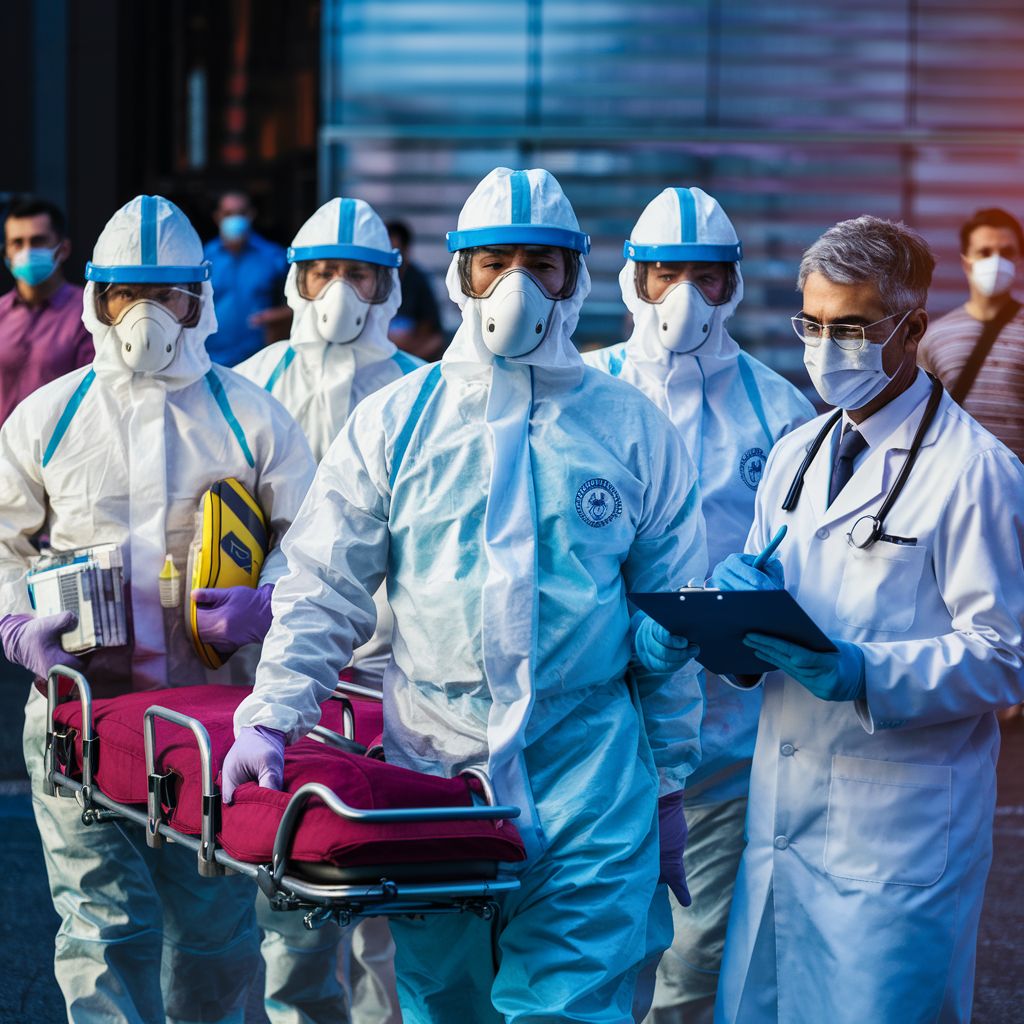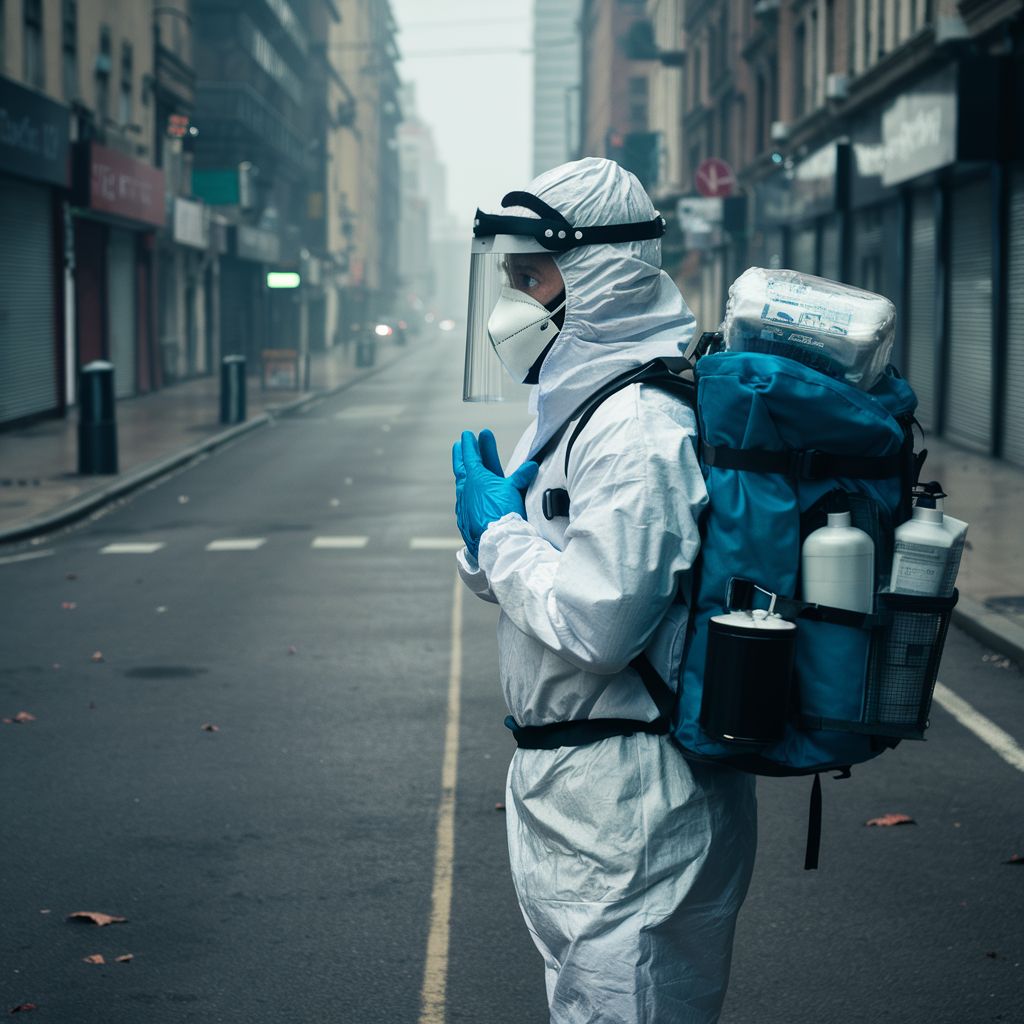Pandemic Preparedness for the Future in 2024
Contents
- 1 Pandemic Preparedness for the Future in 2024
- 1.1 2024 and Beyond: Building a Resilient Future Against Pandemics
- 1.2 Why Pandemic Preparedness Matters: Building a Stronger Future
- 1.3 read more posts
- 1.4 Lessons Learned from COVID-19
- 1.5 Building a Fortress Against Pandemics: Key Components for a More Prepared Future
- 1.6 read more posts
- 1.7 A Looming Shadow: Potential Threats and Challenges on the Pandemic Horizon
- 1.8 read more posts
- 1.9 Taking Action: Building a Collective Shield Against Pandemics
- 1.10 read more posts
- 1.11 Conclusion: Building a Shared Future, Safeguarding Global Health
- 1.12 read more posts
- 1.13 FAQ Section
- 1.14 read more posts
Read DISCLAIMER
Don’t get caught off guard! This comprehensive guide explores pandemic preparedness in 2024 and beyond. Learn key strategies for building a more resilient future against infectious diseases.
2024 and Beyond: Building a Resilient Future Against Pandemics
The scars of the COVID-19 pandemic serve as a stark reminder of our vulnerability to infectious diseases. While the immediate crisis may seem to be receding, experts warn that new pandemics are a constant threat. In 2024, prioritizing pandemic preparedness is not just essential, it’s our collective responsibility. This blog post equips you with the knowledge and resources to navigate future outbreaks with greater confidence.

Why Pandemic Preparedness Matters: Building a Stronger Future
Imagine a world where a novel virus emerges, but this time, we’re ready. Robust public health measures are swiftly implemented, containing the outbreak before it spirals out of control. Hospitals are well-equipped, healthcare workers are well-trained, and clear communication keeps the public informed. This future of mitigated risk and minimized disruption is what pandemic preparedness strives for.
Here’s a deeper look at why pandemic preparedness matters:
• Protecting Ourselves and Loved Ones:
When a pandemic strikes, the health of ourselves and our loved ones becomes a top priority. Preparedness allows us to take proactive steps to minimize the risk of infection, such as having stockpiles of essential supplies, knowing quarantine protocols, and understanding how to protect ourselves from the specific virus.
• Safeguarding Public Health:
Pandemics don’t just impact individuals, they affect entire communities. By prioritizing preparedness, we contribute to a stronger public health system that can effectively manage outbreaks. This includes having adequate medical supplies, trained personnel, and infrastructure to handle a surge in cases.
• Minimizing Disruption:
Pandemics can wreak havoc on economies and social structures. Businesses close, travel is restricted, and social interactions are limited. Effective preparedness helps to minimize these disruptions by allowing for a more controlled response, minimizing the need for harsh lockdowns, and facilitating a faster return to normalcy.
• Building a More Resilient Future:
Pandemics are a reality, not a possibility. By investing in preparedness now, we build a more resilient future for generations to come. This includes fostering international cooperation, developing effective vaccines and treatments, and educating the public on how to stay safe during outbreaks.
In essence, pandemic preparedness isn’t just about reacting to a crisis, it’s about building a future where we are better equipped to handle them. It’s about taking control and creating a world where pandemics disrupt less and threaten less.
read more posts
Lessons Learned from COVID-19
The COVID-19 pandemic exposed vulnerabilities in global preparedness. Delays in detection, inadequate testing capacity, and a lack of coordinated response measures hampered containment efforts. The pandemic also highlighted the importance of robust healthcare systems, clear communication, and international cooperation.

Building a Fortress Against Pandemics: Key Components for a More Prepared Future
The COVID-19 pandemic exposed the cracks in our global armor. But from the ashes, we can forge a more prepared future. Here are the essential building blocks for a world better equipped to handle future outbreaks:
• Early Warning Systems:
The Eyes and Ears of Preparedness: Imagine a global network that can detect emerging threats early on. Strengthening disease surveillance systems, with real-time data collection and analysis, allows for a swift and targeted response before an outbreak spirals out of control. This could involve improved animal disease monitoring, enhanced global cooperation on information sharing, and investment in rapid diagnostic tools.
• Rapid Response and Containment:
Stopping the Virus in its Tracks: Once a threat is identified, a swift and coordinated response is crucial. This includes measures like contact tracing, where infected individuals are identified and their close contacts are notified and monitored. Quarantine protocols can help prevent further transmission by isolating infected individuals. By acting quickly and decisively, we can effectively contain outbreaks and minimize their impact.
• Resilient Healthcare Systems:
The Backbone of Outbreak Response: A strong healthcare system is the foundation for effectively managing outbreaks. This requires investment in infrastructure, including well-equipped hospitals, surge capacity to handle an influx of patients, and a sufficient workforce of trained medical professionals. Stockpiling essential medical supplies, like personal protective equipment (PPE) and ventilators, is also crucial to ensure healthcare workers are protected and equipped to treat the sick.
• Clear Communication:
Building Trust and Promoting Adherence: Effective communication is a cornerstone of pandemic preparedness. Disseminating accurate and timely information from trusted sources like health agencies fosters public trust and encourages adherence to public health guidelines. Clear communication also combats misinformation and empowers individuals to take steps to protect themselves and their communities.
• Global Collaboration:
A United Front Against Pandemics: No nation can combat a pandemic alone. International cooperation is essential for a unified global response. This includes collaboration on research and development of vaccines and treatments, sharing of best practices, and coordinated efforts to monitor and track outbreaks. By working together, we can leverage the expertise and resources of the global community to effectively address future threats.
By focusing on these key components, we can build a more prepared future. A future where we are not caught off guard by emerging infectious diseases, but rather, one where we have the tools and resources to effectively mitigate their impact and safeguard global health security.
read more posts

A Looming Shadow: Potential Threats and Challenges on the Pandemic Horizon
While the scars of COVID-19 are still fresh, complacency is a dangerous path. Here’s a closer look at some of the potential threats and challenges we may face in the future:
• The Unseen Enemy:
Anticipated Pandemics: New and unknown infectious diseases are constantly emerging. Just as we’ve seen with COVID-19, novel viruses can jump from animals to humans, sparking devastating outbreaks. Investing in virus discovery and surveillance programs is crucial to identify these threats early.
• A Changing World:
Climate Change and Zoonotic Diseases: Climate change disrupts ecosystems, alters animal migration patterns, and increases the risk of zoonotic diseases. These are diseases that can jump from animals to humans, with the potential to cause major outbreaks. Addressing climate change and strengthening wildlife disease monitoring programs are vital steps to mitigate this risk.
• An Infodemic Threat:
Misinformation and Vaccine Hesitancy: The spread of misinformation and vaccine hesitancy can be just as dangerous as a virus itself. During a pandemic, accurate information is essential for promoting public health measures and encouraging vaccination. Combating misinformation requires promoting media literacy and ensuring clear communication from trusted sources.
• A Divided World:
Equity and Access Issues: A truly effective global response to a pandemic requires equity in access to resources. This includes ensuring all nations have access to vaccines, diagnostics, and healthcare services. Disparities in access can create pockets of vulnerability, allowing outbreaks to persist and potentially mutate. Strengthening global health partnerships and promoting equitable access are crucial to building a more resilient world.
These are just some of the potential challenges we face. By acknowledging these threats and taking proactive measures, we can be better prepared to navigate the uncertainties of the future. Investing in research, fostering international collaboration, and promoting public health education are all crucial steps towards building a more resilient future in the face of pandemics.
read more posts

Taking Action: Building a Collective Shield Against Pandemics
The responsibility for pandemic preparedness doesn’t fall solely on governments and health organizations. We, as individuals and communities, all have a role to play in building a more resilient future. Here’s how we can take action:
Individual Action: Empowering Yourself
• Stay Informed:
Knowledge is power. Follow reliable sources of information from trusted health agencies like the World Health Organization (WHO) and national public health authorities. This allows you to make informed decisions and avoid misinformation during an outbreak.
• Practice Good Hygiene:
Simple hygiene practices like frequent handwashing, respiratory etiquette (covering coughs and sneezes), and maintaining a clean environment are essential to prevent the spread of germs and viruses.
• Prioritize Your Health:
Maintaining a healthy lifestyle through a balanced diet, regular exercise, and adequate sleep strengthens your immune system, making you more resistant to infections.
• Get Vaccinated:
Vaccines are one of the most effective tools we have to prevent infectious diseases. Stay up-to-date on your vaccinations and encourage others to do the same.
Collective Action: Strengthening Our Communities
• Support Public Health Initiatives:
Advocate for increased funding and resources for research and development of vaccines, diagnostics, and treatments. Public health agencies need the necessary tools to effectively prepare for and respond to outbreaks.
• Promote Community Preparedness:
Get involved in local preparedness efforts. This could involve volunteering with organizations that are working on preparedness initiatives or simply having conversations within your community about how to stay safe during a pandemic.
• Encourage Open Communication:
Open communication within your community is vital. Discuss preparedness plans with your family, neighbors, and colleagues. Help to create a culture of trust and information sharing.
• Prepare a Basic Kit:
Having a basic emergency kit at home can be crucial during a pandemic. This kit should include essentials like non-perishable food, water, medications, first-aid supplies, and sanitation items.
By taking these steps, both individually and collectively, we can build a more resilient future. We can create a world where communities are empowered, informed, and prepared to face the challenges of future pandemics. Remember, even small actions can make a big difference in protecting ourselves, our loved ones, and our communities. Let’s work together to build a future where we are no longer at the mercy of pandemics, but rather, a world where we are ready to face them head-on.
read more posts
The COVID-19 pandemic was a wake-up call. It shattered any illusions of invincibility and exposed the vulnerabilities in our global preparedness. However, from the ashes of this crisis, an opportunity arises. The opportunity to build a more resilient future, a future where we are not just prepared for pandemics, but actively work to prevent them.
This future requires a collective effort. Governments, health organizations, and individuals all have a role to play. Investing in robust public health systems with adequate resources and trained personnel is crucial. Strengthening disease surveillance and early warning systems allows for a swift and effective response to emerging threats. International cooperation in research, development, and resource sharing fosters a unified global approach.
But preparedness goes beyond just systems and resources. Empowering individuals and communities is equally important. This means promoting public health education, encouraging good hygiene practices, and fostering open communication within communities. By working together, we can create a culture of preparedness and build a collective shield against future pandemics.
The future holds uncertainties, but by prioritizing pandemic preparedness today, we can shape a tomorrow where we are not just reactive, but proactive. A future where we safeguard global health security and ensure the well-being of generations to come. Let’s work together, let’s be informed, and let’s build a more resilient future – a future where we are prepared to face whatever challenges may lie ahead.
read more posts
FAQ Section
1. What are some key components of pandemic preparedness?
Early warning systems, rapid response measures, resilient healthcare systems, clear communication, and global collaboration are all crucial elements.
2. What are some anticipated future pandemic threats?
New infectious diseases, climate change-driven zoonotic diseases, and misinformation pose significant challenges.
3. How can I prepare for a future pandemic?
Stay informed, practice good hygiene, support public health initiatives, and promote preparedness within your community.
4. What are some reliable sources of information on pandemics?
The World Health Organization (WHO), national health agencies, and reputable medical websites are trustworthy sources.
5. How can I protect myself from infectious diseases?
Frequent handwashing, respiratory etiquette (covering coughs and sneezes), and maintaining a healthy lifestyle are essential preventive measures.
6. What is the role of vaccines in pandemic preparedness?
Vaccines play a critical role in preventing the spread of infectious diseases and reducing the severity of illness.
7. What is contact tracing and how does it help control outbreaks?
Contact tracing involves identifying people who have been in contact with an infected individual to inform them of their potential exposure and encourage them to get tested and quarantine if necessary. This helps to break the chain of transmission.
8. What is social distancing and how does it work?
Social distancing refers to maintaining a physical distance between yourself and others to reduce the risk of transmission of a respiratory virus. This can include avoiding crowded places, maintaining a safe distance during interactions, and avoiding physical contact like handshakes.
9. What are some of the economic consequences of a pandemic?
Pandemics can disrupt supply chains, force business closures, and lead to job losses, resulting in economic downturns.
10. How can mental health be addressed during a pandemic?
The stress and uncertainty of a pandemic can take a toll on mental health. Maintaining social connections, practicing self-care, and seeking professional help when needed are crucial for mental well-being.
11. What are some ethical considerations during a pandemic?
During a pandemic, ethical considerations arise regarding resource allocation, vaccine equity, and balancing public health measures with individual freedoms.
12. What is the role of technology in pandemic preparedness?
Technological advancements can play a significant role in areas like disease surveillance, rapid diagnostics, data analysis, and telemedicine, facilitating a more effective response.
13. How can misinformation be addressed during a pandemic?
It’s crucial to rely on trusted sources of information like health professionals and reputable scientific institutions. Be critical of information shared online and verify its accuracy before sharing it further.
14. What is the role of individuals in promoting community preparedness?
Individuals can contribute by staying informed, practicing good hygiene, and encouraging others to do the same. They can also participate in local preparedness initiatives and promote community discussions.
15. What are some positive developments in pandemic preparedness since COVID-19?
There has been increased global collaboration, investment in research and development, and a renewed focus on strengthening healthcare systems. Technological advancements are also offering promising tools for future outbreaks.
Subscribe to our blog for more informative content on health, wellness, and building a resilient future. Share this post with your friends and family to spread awareness about pandemic preparedness. Let’s work together to create a safer and healthier world for all.
Meta Description: Don’t get caught off guard! This comprehensive guide explores pandemic preparedness in 2024 and beyond. Learn key strategies for building a more resilient future against infectious diseases.


Very interesting details you have remarked, regards for
posting.!
Thanks, I have just been looking for information about this subject for a long time and yours is the best I’ve discovered till now. However, what in regards to the bottom line? Are you certain in regards to the supply?
Thanks for sharing. I read many of your blog posts, cool, your blog is very good.
Can you be more specific about the content of your article? After reading it, I still have some doubts. Hope you can help me.
Can you be more specific about the content of your article? After reading it, I still have some doubts. Hope you can help me.